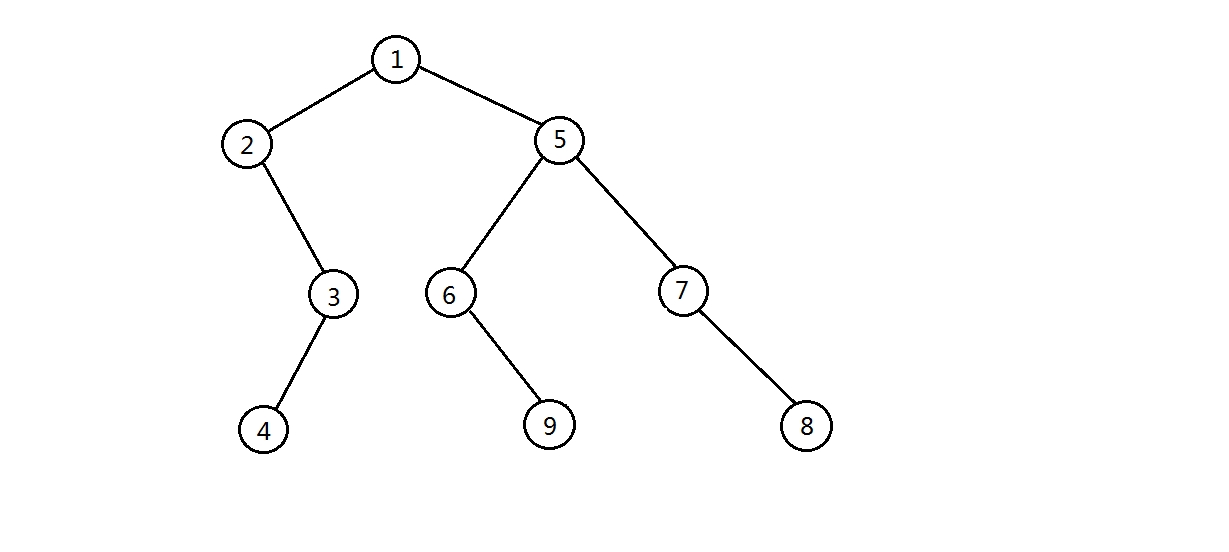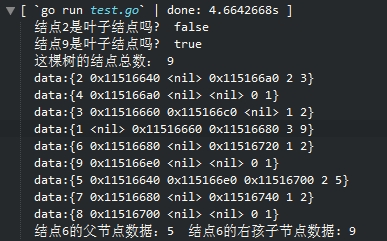二叉树的理论知识,应该都比较了解了,下文不再详细介绍二叉树的基本知识。
在二叉树中具有以下重要性质:
1.在二叉树的第i层上最多有(2的i次方)个结点。
2.高度为h的二叉树至多有(2的h+1次方-1)个结点。
3.对任何一棵二叉树,如果其终端结点(叶子结点)数为n0,度为2的结点数为n2,则n0 = n2 + 1。
下面就直接贴出golang的二叉树代码,由binaryTreeNode.go和binaryTree.go两个文件组合:
binaryTreeNode.go:
(
|
1
2
3
4
5
6
7
8
9
10
11
12
13
14
15
16
17
18
19
20
21
22
23
24
25
26
27
28
29
30
31
32
33
34
35
36
37
38
39
40
41
42
43
44
45
46
47
48
49
50
51
52
53
54
55
56
57
58
59
60
61
62
63
64
65
66
67
68
69
70
71
72
73
74
75
76
77
78
79
80
81
82
83
84
85
86
87
88
89
90
91
92
93
94
95
96
97
98
99
100
101
102
103
104
105
106
107
108
109
110
111
112
113
114
115
116
117
118
119
120
121
122
123
124
125
126
127
128
129
130
131
132
133
134
135
136
137
138
139
140
141
142
143
144
145
146
147
148
149
150
151
152
153
154
155
156
157
158
159
160
161
162
163
164
165
166
167
168
169
170
171
172
173
174
175
176
177
178
179
180
181
182
183
184
185
186
187
|
package
tree
import
(
"math"
)
//二叉树节点
type BinTreeNode struct {
data
interface
{}
//数据域
parent *BinTreeNode
//父节点
lChild *BinTreeNode
//左孩子
rChild *BinTreeNode
//右孩子
height
int
//以该结点为根的子树的高度
size
int
//该结点子孙数(包括结点本身)
}
func NewBinTreeNode(e
interface
{}) *BinTreeNode {
return
&BinTreeNode{data: e, size:
1
}
}
//获得节点数据
func (
this
*BinTreeNode) GetData()
interface
{} {
if
this
== nil {
return
nil
}
return
this
.data
}
//设置节点数据
func (
this
*BinTreeNode) SetData(e
interface
{}) {
this
.data = e
}
//判断是否有父亲
func (
this
*BinTreeNode) HasParent() bool {
return
this
.parent != nil
}
//获得父亲节点
func (
this
*BinTreeNode) GetParent() *BinTreeNode {
if
!
this
.HasParent() {
return
nil
}
return
this
.parent
}
//设置父亲节点
func (
this
*BinTreeNode) setParent(p *BinTreeNode) {
this
.parent = p
// this.parent.SetHeight() //更新父结点及其祖先高度
// this.parent.SetSize() //更新父结点及其祖先规模
}
//断开与父亲的关系
func (
this
*BinTreeNode) CutOffParent() {
if
!
this
.HasParent() {
return
}
if
this
.IsLChild() {
this
.parent.lChild = nil
//断开该节点与父节点的连接
}
else
{
this
.parent.rChild = nil
//断开该节点与父节点的连接
}
this
.parent = nil
//断开该节点与父节点的连接
this
.parent.SetHeight()
//更新父结点及其祖先高度
this
.parent.SetSize()
//更新父结点及其祖先规模
}
//判断是否有左孩子
func (
this
*BinTreeNode) HasLChild() bool {
return
this
.lChild != nil
}
//获得左孩子节点
func (
this
*BinTreeNode) GetLChild() *BinTreeNode {
if
!
this
.HasLChild() {
return
nil
}
return
this
.lChild
}
//设置当前结点的左孩子,返回原左孩子
func (
this
*BinTreeNode) SetLChild(lc *BinTreeNode) *BinTreeNode {
oldLC :=
this
.lChild
if
this
.HasLChild() {
this
.lChild.CutOffParent()
//断开当前左孩子与结点的关系
}
if
lc != nil {
lc.CutOffParent()
//断开lc与其父结点的关系
this
.lChild = lc
//确定父子关系
lc.setParent(
this
)
this
.SetHeight()
//更新当前结点及其祖先高度
this
.SetSize()
//更新当前结点及其祖先规模
}
return
oldLC
}
//判断是否有右孩子
func (
this
*BinTreeNode) HasRChild() bool {
return
this
.rChild != nil
}
//获得右孩子节点
func (
this
*BinTreeNode) GetRChild() *BinTreeNode {
if
!
this
.HasRChild() {
return
nil
}
return
this
.rChild
}
//设置当前结点的右孩子,返回原右孩子
func (
this
*BinTreeNode) SetRChild(rc *BinTreeNode) *BinTreeNode {
oldRC :=
this
.rChild
if
this
.HasRChild() {
this
.rChild.CutOffParent()
//断开当前左孩子与结点的关系
}
if
rc != nil {
rc.CutOffParent()
//断开rc与其父结点的关系
this
.rChild = rc
//确定父子关系
rc.setParent(
this
)
this
.SetHeight()
//更新当前结点及其祖先高度
this
.SetSize()
//更新当前结点及其祖先规模
}
return
oldRC
}
//判断是否为叶子结点
func (
this
*BinTreeNode) IsLeaf() bool {
return
!
this
.HasLChild() && !
this
.HasRChild()
}
//判断是否为某结点的左孩子
func (
this
*BinTreeNode) IsLChild() bool {
return
this
.HasParent() &&
this
==
this
.parent.lChild
}
//判断是否为某结点的右孩子
func (
this
*BinTreeNode) IsRChild() bool {
return
this
.HasParent() &&
this
==
this
.parent.rChild
}
//取结点的高度,即以该结点为根的树的高度
func (
this
*BinTreeNode) GetHeight()
int
{
return
this
.height
}
//更新当前结点及其祖先的高度
func (
this
*BinTreeNode) SetHeight() {
newH :=
0
//新高度初始化为0,高度等于左右子树高度加1中的大者
if
this
.HasLChild() {
newH =
int
(math.Max(float64(newH), float64(
1
+
this
.GetLChild().GetHeight())))
}
if
this
.HasRChild() {
newH =
int
(math.Max(float64(newH), float64(
1
+
this
.GetRChild().GetHeight())))
}
if
newH ==
this
.height {
//高度没有发生变化则直接返回
return
}
this
.height = newH
//否则更新高度
if
this
.HasParent() {
this
.GetParent().SetHeight()
//递归更新祖先的高度
}
}
//取以该结点为根的树的结点数
func (
this
*BinTreeNode) GetSize()
int
{
return
this
.size
}
//更新当前结点及其祖先的子孙数
func (
this
*BinTreeNode) SetSize() {
this
.size =
1
//初始化为1,结点本身
if
this
.HasLChild() {
this
.size +=
this
.GetLChild().GetSize()
//加上左子树规模
}
if
this
.HasRChild() {
this
.size +=
this
.GetRChild().GetSize()
//加上右子树规模
}
if
this
.HasParent() {
this
.parent.SetSize()
//递归更新祖先的规模
}
}
|
binaryTree.go:
|
1
2
3
4
5
6
7
8
9
10
11
12
13
14
15
16
17
18
19
20
21
22
23
24
25
26
27
28
29
30
31
32
33
34
35
36
37
38
39
40
41
42
43
44
45
46
47
48
49
50
51
52
53
54
55
56
57
58
59
60
61
62
63
64
65
66
67
68
69
70
71
72
73
74
75
76
77
78
79
80
81
82
83
84
85
86
87
88
89
90
91
92
93
94
95
96
97
98
99
100
101
102
103
104
105
106
107
108
109
110
111
112
113
114
115
116
|
package
tree
import
(
"container/list"
)
//二叉树
type binaryTree struct {
root *BinTreeNode
//根节点
height
int
size
int
}
func NewBinaryTree(root *BinTreeNode) *binaryTree {
return
&binaryTree{root: root}
}
//获得二叉树总结点数
func (
this
*binaryTree) GetSize()
int
{
return
this
.root.size
}
//判断二叉树是否为空
func (
this
*binaryTree) IsEmpty() bool {
return
this
.root != nil
}
//获得二叉树根节点
func (
this
*binaryTree) GetRoot() *BinTreeNode {
return
this
.root
}
//获得二叉树高度,根节点层为0
func (
this
*binaryTree) GetHeight()
int
{
return
this
.root.height
}
//获得第一个与数据e相等的节点
func (
this
*binaryTree) Find(e
interface
{}) *BinTreeNode {
if
this
.root == nil {
return
nil
}
p :=
this
.root
return
isEqual(e, p)
}
func isEqual(e
interface
{}, node *BinTreeNode) *BinTreeNode {
if
e == node.GetData() {
return
node
}
if
node.HasLChild() {
lp := isEqual(e, node.GetLChild())
if
lp != nil {
return
lp
}
}
if
node.HasRChild() {
rp := isEqual(e, node.GetRChild())
if
rp != nil {
return
rp
}
}
return
nil
}
//先序遍历,并保存在链表里
func (
this
*binaryTree) PreOrder() *list.List {
traversal := list.New()
preOrder(
this
.root, traversal)
return
traversal
}
func preOrder(rt *BinTreeNode, l *list.List) {
if
rt == nil {
return
}
l.PushBack(rt)
preOrder(rt.GetLChild(), l)
preOrder(rt.GetRChild(), l)
}
//中序遍历,并保存在链表里
func (
this
*binaryTree) InOrder() *list.List {
traversal := list.New()
inOrder(
this
.root, traversal)
return
traversal
}
func inOrder(rt *BinTreeNode, l *list.List) {
if
rt == nil {
return
}
inOrder(rt.GetLChild(), l)
l.PushBack(rt)
inOrder(rt.GetRChild(), l)
}
//后序遍历,并保存在链表里
func (
this
*binaryTree) PostOrder() *list.List {
traversal := list.New()
postOrder(
this
.root, traversal)
return
traversal
}
func postOrder(rt *BinTreeNode, l *list.List) {
if
rt == nil {
return
}
postOrder(rt.GetLChild(), l)
postOrder(rt.GetRChild(), l)
l.PushBack(rt)
}
|
上述遍历的过程显然是一个递归的过程,算法中是将结点加入链接表list的尾部作为对结点的访问,该操作只需要常数时间即可完成。在算法的递归执行过程中,每个结点访问且仅被访问一次,因此算法的时间复杂度T(n) = Ο(n)。对于中序和后序遍历的递归算法也是如此,即中序和后序递归算法的时间复杂度也是Ο(n)。
下面做下测试,创建这么一棵二叉树:
测试代码:
|
1
2
3
4
5
6
7
8
9
10
11
12
13
14
15
16
17
18
19
20
21
22
23
24
25
26
27
28
29
30
31
32
33
34
35
|
package
main
import
(
"dataStructures/tree"
"fmt"
)
func main() {
a := tree.NewBinTreeNode(
1
)
tree1 := tree.NewBinaryTree(a)
a.SetLChild(tree.NewBinTreeNode(
2
))
a.SetRChild(tree.NewBinTreeNode(
5
))
a.GetLChild().SetRChild(tree.NewBinTreeNode(
3
))
a.GetLChild().GetRChild().SetLChild(tree.NewBinTreeNode(
4
))
a.GetRChild().SetLChild(tree.NewBinTreeNode(
6
))
a.GetRChild().SetRChild(tree.NewBinTreeNode(
7
))
a.GetRChild().GetLChild().SetRChild(tree.NewBinTreeNode(
9
))
a.GetRChild().GetRChild().SetRChild(tree.NewBinTreeNode(
8
))
node2 := a.GetLChild()
node9 := a.GetRChild().GetLChild().GetRChild()
fmt.Println(
"结点2是叶子结点吗? "
, node2.IsLeaf())
fmt.Println(
"结点9是叶子结点吗? "
, node9.IsLeaf())
fmt.Println(
"这棵树的结点总数:"
, tree1.GetSize())
l := tree1.InOrder()
//中序遍历
for
e := l.Front(); e != nil; e = e.Next() {
obj, _ := e.Value.(*tree.BinTreeNode)
fmt.Printf(
"data:%v\n"
, *obj)
}
result := tree1.Find(
6
)
fmt.Printf(
"结点6的父节点数据:%v\t结点6的右孩子节点数据: %v\n"
, result.GetParent().GetData(), result.GetRChild().GetData())
}
|
结果:
看下中序遍历后,list内存储节点的顺序:2,4,3,1,6,9,5,7,8.符合这棵树中序遍历的结果。
本文转自 ponpon_ 51CTO博客,原文链接:http://blog.51cto.com/liuxp0827/1378672,如需转载请自行联系原作者

